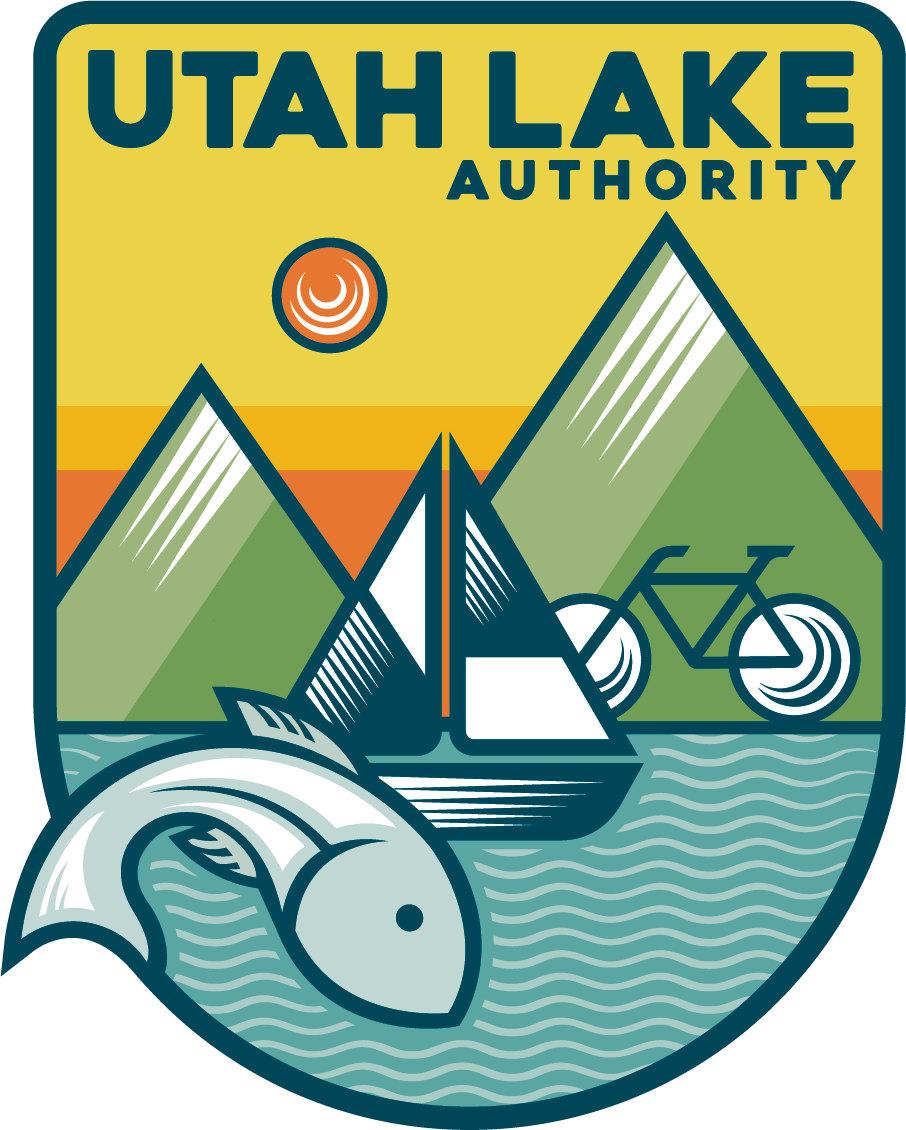Welcome to our FAQ page! We’ve compiled a list of the most commonly asked questions and their answers to help you find the information you need quickly and easily. To make navigation a breeze, we’ve used an Accordion style layout. This means you can click on each question to reveal its answer. If you have a specific question in mind, simply look through the list and click on the question to view the answer. If your question isn’t listed, feel free to reach out to us directly!
Utah Lake Authority (ULA)
The Utah Lake Authority is an organization dedicated to fostering a vibrant recreational environment, facilitating enhancements, and implementing sustainable management practices at Utah Lake. We collaborate with government entities, local property owners, and community members to nurture a shared passion for the lake’s natural beauty, environmental health, and recreational opportunities. Our mission is anchored in three pillars: Fostering Thriving Ecosystems, Cultivating Vibrant Communities, and Delivering World-Class Recreation. We are committed to educating the public on the lake’s delicate balance, ensuring safe interactions with the habitat, and protecting and enhancing Utah Lake’s ecosystems. We are also dedicated to developing spaces where families, friends, and neighbors can connect and create lasting memories. From serene mornings on the water to exhilarating afternoons under the sun, we are all about creating exceptional experiences. The Utah Lake Authority supports initiatives that reflect the core values of fostering a harmonious balance between recreational enjoyment and ecological health, cultivating strong partnerships, advocating for responsible stewardship, expanding access and opportunities for recreation, and driving economic vitality. We strive to protect, preserve, and promote Utah Lake, ensuring it remains a vibrant and life-affirming resource for all.
The transition from the Utah Lake Commission (ULC) to the Utah Lake Authority (ULA) was part of a strategic plan to steer the lake towards a brighter future. The ULC was required to cooperate with the ULA to transition its functions to the ULA as soon as practicable. This transition was consistent with the chapter of the Utah Lake Authority Act. The ULC was also required to take all necessary actions to dissolve itself no later than May 1, 2023. The ULA took the helm with a mission anchored in three pillars: fostering thriving ecosystems, cultivating vibrant communities, and delivering world-class recreation. They are not just about the serious business of safeguarding Utah Lake’s natural beauty; they’re also here to splash a bit of fun into the mix. They believe in the joy of discovery and the spirit of adventure that the lake offers to everyone. In essence, the transition was made to enhance the management of Utah Lake, ensuring it remains a vibrant and life-affirming resource for all. The ULA is now the fresh face on the scene, dedicated to nurturing a thriving ecosystem and community.
The ULA has several key responsibilities aimed at preserving and enhancing Utah Lake. We work to ensure a balance between recreational enjoyment and ecological health, ensuring that the lake’s multiple uses thrive together. We enhance communication and collaboration between the Authority, community stakeholders, and the public. We are committed to responsibly managing resources and protecting the lake’s beauty. We work to allow everyone to experience the lake’s amenities. We also monitor and encourage developments that contribute positively to the region’s prosperity. In essence, the ULA is responsible for this treasured natural resource and supports initiatives that reflect its core values. We strive to protect, preserve, and promote Utah Lake, ensuring it remains a vibrant and life-affirming resource for all. The ULA team is composed of dedicated individuals united by their deep appreciation for Utah Lake. Our passion goes beyond the beauty of the landscapes and the enjoyment they bring; it’s rooted in a commitment to nurturing a thriving ecosystem and community.
The Utah Lake Authority (ULA) plays a crucial role in managing Utah Lake and assisting other parties involved with the lake. We coordinate the efforts of all applicable state and local government entities, property owners, owners of water rights, and other private parties, and other stakeholders. Together, we develop and implement a management plan for Utah Lake. This plan includes an environmental sustainability component, developed in conjunction with the Department of Environmental Quality and the Division of Wildlife Resources. It incorporates strategies and best management practices to meet applicable federal and state standards. This includes water quality monitoring and reporting, and strategies that use the best available technology and practices to mitigate environmental impacts from management and uses on Utah Lake. The ULA also develops strategies that enhance the aesthetic qualities and recreational use and enjoyment of Utah Lake. We plan and facilitate the management of Utah Lake uses. In essence, the ULA works in concert with various entities to encourage, facilitate, and implement the management of Utah Lake. We are committed to ensuring that Utah Lake remains a vibrant and life-affirming resource for all.
Algae
Not all blooms become toxic, we still don’t understand why toxins are produced sometimes and not other times. But we do know that if blooms don’t occur, toxins won’t be produced in amounts that could hurt us. If a bloom is occurring, it’s a good idea to stay out of the water even if we don’t know whether it’s toxic or not.
A combination of factors contributes to harmful algal blooms. They are the same things that help plants grow in the spring: warm temperatures, ample sunlight, and plenty of algae food (phosphorus and nitrogen that we call “nutrients”). Some of these things we can control, like how much nutrients we add to the water. Other things we can’t control, like the weather. We can be very certain that the temperatures will get warm and the sun will shine, especially in the late summer and early fall when these blooms usually happen. Researchers continue to work to better understand how these factors interact to create harmful algal blooms.
Read our blog post to learn more.
Not necessarily, algae are an important part of the lake ecosystem and provide food for the insects that fish rely on to survive. It’s only when the algae get thick and noxious that it becomes a problem for people and the fish that live in the water. There is also a specific kind of algae called “blue-green algae” that is especially concerning for people, pets, livestock. and wildlife, as it can produce harmful toxins and cause rashes, skin and eye irritation, allergic reactions, gastrointestinal upset, and other effects. You can usually tell when a blue-green algae bloom is occurring in that it will look like someone has poured blue-green paint in the water.
For safety from harmful algal blooms (HABs) at Utah Lake, it’s crucial to avoid contact with water that appears green, as this often indicates the presence of bacteria, specifically algae or filamentous cyanobacteria. When these organisms are visible or the water is green, it suggests cyanobacteria are growing and dispersed in the water column, which can be harmful.
Therefore, vigilance is advised when interacting with bodies of water, especially during warm, dry periods. Before visiting Utah Lake, check for any HAB warnings from the Utah Department of Environmental Quality. If you’re boating, avoid areas of algae. If you catch any fish, clean them well and discard the guts. Ensure your pets or livestock do not drink the water or come into contact with the algae. The water in Utah Lake is not safe for drinking, especially during a HAB. Always remember, if you’re unsure about the condition of the water, it’s best to stay out.
To control and prevent harmful algal blooms in Utah Lake, several measures are being implemented:
1. Monitoring: The Utah Department of Environmental Quality conducts regular monitoring of the lake to detect harmful algal blooms. They issue advisories and health watches to keep the public informed about the current conditions.
2. Public Awareness: The public is advised to exercise caution around the lake. This includes avoiding areas of algae when boating, refraining from swimming or water skiing in areas with visible algae, cleaning fish thoroughly and discarding the guts, and not consuming the lake water.
3. Nutrient Pollution Control: Efforts are underway to control nutrient pollution from human sources, a key factor in preventing excessive nutrient enrichment. This involves implementing best practices in agriculture, managing stormwater runoff, and improving wastewater treatment systems.
These measures aim to reduce the occurrence and impact of algal blooms, protect public health, and preserve the ecosystem of Utah Lake. It’s a comprehensive approach that involves monitoring, public education, and pollution control.
Harmful algal blooms (HABs) at Utah Lake can significantly affect recreational activities. During HABs, it’s advised to avoid swimming or water skiing in areas with visible algae due to the potential presence of dangerous toxins that can harm humans and animals. While boating is generally permitted, boaters should steer clear of algal areas to prevent exposure to these toxins.
Fishing is also impacted as fish caught in the lake should be cleaned thoroughly and their guts discarded, given that toxins from the algae can accumulate in fish guts. Pets and animals should be kept away from the water during algal blooms and should not drink the water due to the risk of toxin exposure.
The Utah Department of Environmental Quality regularly monitors the lake and issues advisories and health watches to keep the public informed about current conditions. These measures aim to protect public health and preserve the recreational value of Utah Lake.
Algal blooms at Utah Lake, particularly those caused by cyanobacteria (blue-green algae), can pose health risks for both humans and animals. Direct contact or inhalation can lead to skin, eye, ear, nose, and respiratory irritation. Ingesting contaminated water can result in gastrointestinal issues like abdominal pain and vomiting. Swimmers and waders may experience skin rashes, a runny nose, a sore throat, and stomach problems. More serious health concerns can also arise. Animals ingesting large amounts of bloom-infested water can exhibit symptoms such as excessive drooling, vomiting, stumbling, excessive scratching, rashes, and difficulty breathing. While the lake remains open during blooms, precautions are advised such as avoiding high algae concentration areas, not drinking lake water, and keeping pets away from the water.
Visitors can stay informed about current conditions and advisories related to algae blooms at Utah Lake through several resources. The Utah Department of Environmental Quality (DEQ) provides regular updates on water quality and issues advisories when necessary. For the most up-to-date information, visitors can check the DEQ’s website. Marinas at Utah Lake, both public and private, have educational signage with photos to help recognize algae, safety recommendations, and contact information for more resources. By staying informed and following the advisories, visitors can ensure a safe and enjoyable experience at Utah Lake.
General Lake Questions
Utah Lake is the largest freshwater lake in the United States west of the Mississippi River. It covers an area of approximately 150 square miles (390 square km) and is 23 miles (37 km) long. The lake spans up to 24 miles in length and 13 miles in width. It occupies over one-fourth of the valley floor of Utah Valley and contains about 900,000 acre feet of water. The average depth of the lake is about 10.5 feet (3.2 m), and the maximum depth is about 14 feet (4.3 m). The lake’s depth can vary depending on weather conditions and irrigation deliveries.
Utah Lake, a shallow freshwater lake in Utah County, has a rich history and significant ecological and cultural importance. First seen by European Father Silvestre Vélez de Escalante in 1776, the lake was later settled by Latter-Day Saints in 1849. It’s a remnant of the much larger Pleistocene Lake Bonneville.
The lake has faced pollution challenges, including harmful algal blooms caused by excess nutrients, particularly phosphorus. Human activities, such as discharges from wastewater treatment plants and agricultural runoff, have contributed to these issues. However, recent years have seen a shift towards restoration and conservation efforts to create a balanced environment for ecosystems, recreation, and communities.
Culturally, Utah Lake has been a vital resource for thousands of years. Native American cultures utilized its food resources, and the lake has been used for hunting, fishing, gathering, and worship. For Latter-Day Saints, the lake’s fish helped sustain early settlers. Today, Utah is home to more than 2 million Latter-day Saints, underscoring the lake’s ongoing cultural significance.
For a more in-depth history of Utah Lake, consider watching the Utah Lake Legacy video. This resource provides a comprehensive exploration of the lake’s past, enhancing your understanding of its ecological, cultural, and historical significance.
If you find trash at Utah Lake, you should contact the appropriate authorities to ensure it’s properly addressed.
You can reach out to Heather at [email protected]. She will be able to guide you on the necessary steps to take. Or you can fill out a message form here. Remember, every effort helps in maintaining the cleanliness and beauty of Utah Lake.
There are several misconceptions about Utah Lake that often stem from a lack of understanding about the lake’s unique ecosystem and natural processes. It’s always a good idea to research and learn more about such topics to gain a more accurate understanding of Utah Lake. Here are some key points:
Smelly Water and Gnats in Summer
People often believe that the lake’s water is smelly and full of gnats in the summer. While the lake can have a distinct smell and gnats can be present, these are natural occurrences and do not indicate that the lake is unhealthy or unsafe.
High Pollution
Many believe that Utah Lake is highly polluted, a perception reinforced when wind stirs up the lake’s loose bottom, turning the water muddy. However, the lake’s water and fish are healthier than perceived. The muddiness actually helps protect the lake’s water quality and fish by reducing sunlight penetration, which is necessary for harmful algae production.
If you’re interested in actively participating, visit our ‘Volunteer Opportunities’ page to find upcoming projects. For those who have a general interest in the lake and wish to receive updates, and news, consider signing up for our email list.
No! It is not the dirtiest lake in the US.
Utah Lake, one of the largest natural freshwater lakes in the western United States, has faced several water quality issues. The lake is considered hypereutrophic, meaning it is overly rich in nutrients such as nitrogen and phosphorous. These excessive concentrations of nutrients can cause large seasonal algal blooms, elevated pH, and possible cyanotoxin production during harmful algal blooms.
Historically, raw sewage was dumped into the lake as late as 1967. The lake’s phosphorus and mineral salt levels have been in violation of the Clean Water Act. In recent years, the lake has been prone to harmful algal blooms or HABs.
However, it’s important to note that the term “dirtiest” can be subjective and depends on the specific parameters used to assess water quality. While Utah Lake has had its share of issues, many efforts are being made to improve its water quality. The Utah Department of Environmental Quality has been conducting a Utah Lake Water Quality Study with the goal of developing nitrogen and phosphorus criteria that are protective of the lake’s designated beneficial uses.
In addition to these efforts, the Utah Lake Authority has been working to improve the lake by increasing social community outreach, organizing lake-related events that help the lake’s ecosystem, communities, and recreation, and enhancing safety measures.
So, while Utah Lake has faced significant water quality challenges, it might not be accurate to label it as the “dirtiest” lake without a comprehensive comparison of water quality data from other lakes around the world. It’s also worth noting that “dirtiness” can be temporary and reversible with appropriate management and conservation efforts.
UTAH LAKE’S ECOSYSTEM
Utah lake like any other body of water does face several environmental challenges such as:
1
Harmful Algal Blooms:
The summer and early fall are the prime seasons for harmful algal blooms, which are triggered by several factors. These factors include abundant sunlight, high temperatures, an excess of nutrients like phosphorus in the water, and stagnant water conditions.
2
Nutrient pollution:
With the population increasing, the lake receives a greater influx of nutrients. Nutrient pollution can be caused by agricultural runoff, such as excess fertilizers like phosphorus, which can contaminate waterways. As the fertilizer seeps into the lake, it triggers a cycle of harmful algal blooms that keep happening.
3
Ecosystem Changes:
The ecosystem in and around the lake, as well as along its tributaries, has undergone significant changes for the past 170 years. Changes such as land use changes, water diversions, and the introduction of non-native both non invasive and invasive plants and animals.
Despite the environmental challenges Utah Lake faces, hope persists. Increased awareness has led to efforts to restore and protect the lake. Solutions are being implemented to reduce pollution and restore habitats. Each of us can contribute to these efforts. With continued dedication, we can ensure a thriving future for Utah Lake. Remember, every small step counts towards environmental preservation
The wetland ecosystem is important to Utah Lake for several reasons:
Biodiversity:
In the Utah Lake wetlands, an impressive 226 species of birds, 49 mammalian species, 16 species of amphibians and reptiles, and 18 species of fish create a thriving ecosystem
Water source:
Wetlands play a critical role as water sources in Utah’s arid climate. It plays a role in water purification and flood control.
Climate regulation:
Wetlands contribute to climate regulation by storing carbon in their plant communities and soil, helping to mitigate greenhouse gas emissions.
Habitat:
The wetlands, with their diverse ecosystem, provide crucial habitats for a variety of organisms. These spots play a crucial role as breeding grounds and resting places for a wide variety of migratory birds. These areas not only offer homes for animals, but also serve as vital sources of food and nourishment.
Recreation:
Wetlands offer a variety of recreational opportunities that attract both locals and tourists. The diverse range of species found in the wetlands make it a particularly attractive spot for nature enthusiasts and wildlife photographers. The serene environment of the wetlands provides a peaceful setting, making it an ideal location for activities such as hiking and picnicking
Utah Lake is the subject of several ongoing conservation efforts aimed at preserving its unique ecosystem. These efforts are spearheaded by various organizations and involve a range of projects.
One of the key initiatives is the Utah Lake Symposium, hosted by the Utah Lake Authority. This event serves as a platform for discussing conservation strategies and updating stakeholders on the progress of current projects. The symposium features presentations from the Utah Division of Water Quality, Division of Wildlife Resources, and researchers from Utah Valley and Utah State universities, and more. Topics covered include the recovery of the June sucker, a native fish species, water quality improvements, and the removal of the invasive common carp.
The June Sucker Recovery program is another significant effort. Launched in 2002, the program has been successful in increasing the population of June suckers from a mere 300 in 1998 to a level that allowed the species to be down listed from endangered to threatened in 2021. The Provo River Delta Restoration Project, initiated in 2020, is a key component of the June sucker recovery. The project aims to provide a safe haven for young fish, offering them spaces to hide from predators.
In addition to these specific projects, the Utah’s Watershed Restoration Initiative works on a broader scale to improve and restore high-priority watersheds and habitats throughout the state. During the fiscal year between July 1, 2022, and June 30, 2023, the initiative improved a total of 148,883 acres across Utah, including 31,518 acres affected by wildfires.
Despite these efforts, challenges remain. Drought, water quality issues, and the presence of nonnative species like the common carp pose ongoing threats to Utah Lake’s ecosystem. Therefore, continuous efforts and coordination among various stakeholders are essential for the successful conservation of this unique ecosystem. The future of Utah Lake depends on our ability to address these challenges and ensure the preservation of its rich biodiversity.
Numerous restoration projects are currently taking place in and around Utah Lake. Individual citizens, cities, the county, the state, and the federal government are all leading and supporting these diverse lake projects. The future holds more conservation and restoration projects, ranging from trail and access point expansions to the establishment of water laws that prioritize conservation. By enhancing and extending ongoing conservation efforts, Utah Lake could experience significant improvements in its condition and future prospects.
Utah Lake, a vital natural resource, is at the heart of our community. Here are ten critical measures currently underway or planned for the future:
1. Cultural Connection and Stewardship: We’re fostering a deeper connection with the lake through outreach, education, and experiences. Community clean-up events, workshops, and recreational activities promote stewardship.
2. Conservation Easement: A permanent conservation easement around the lake ensures ecological health, public access, and community well-being.
3. Water Laws and Flow Enhancement: Improving water laws and conservation practices will increase river flow to the lake, benefiting its overall health.
4. Pollution Reduction: Upgrading wastewater treatment and managing runoff are essential steps to reduce lake pollution.
5.Invasive Species Management: We continue to remove invasive species and restore habitats using ecologically sound methods.
6. Integration into Development Planning: Utah Lake’s health and conservation are integral considerations in future development plans.
7. Protection from Harmful Proposals: We’re safeguarding the lake against proposals that could jeopardize its well-being and our collective future.
8. Ecological Understanding: Supporting efforts to study lake ecology and promote sustainable practices ensures informed decision-making.
9. Advanced Monitoring: Enhancing our monitoring network allows us to track pollutants effectively and address issues early.
10. Cost-Effective Mitigation: Identifying and testing strategies—such as nutrient reduction and habitat restoration—ensures efficient lake management.
Remember, every action matters. By collaborating across government agencies, local communities, and stakeholders, we can secure Utah Lake’s long-term health and sustainability.
FAUNA
Utah Lake is hub of biodiversity, hosting an astounding 226 bird species, 49 mammalian species, 16 amphibian and reptile species, and 18 fish species. Its inhabitants range from native species, integral to the lake’s ecological fabric, to non-native invasive species, which pose a potential threat to its ecological equilibrium. Interestingly, not all non-native fauna are detrimental to the lake’s ecosystem. The dynamic interaction between these native and invasive species is pivotal in determining the health and destiny of Utah Lake. The conservation efforts at Utah Lake lies in comprehending and tackling the issues brought about by invasive species, while simultaneously safeguarding and fostering the native fauna
Examples of Invasive Fauna:
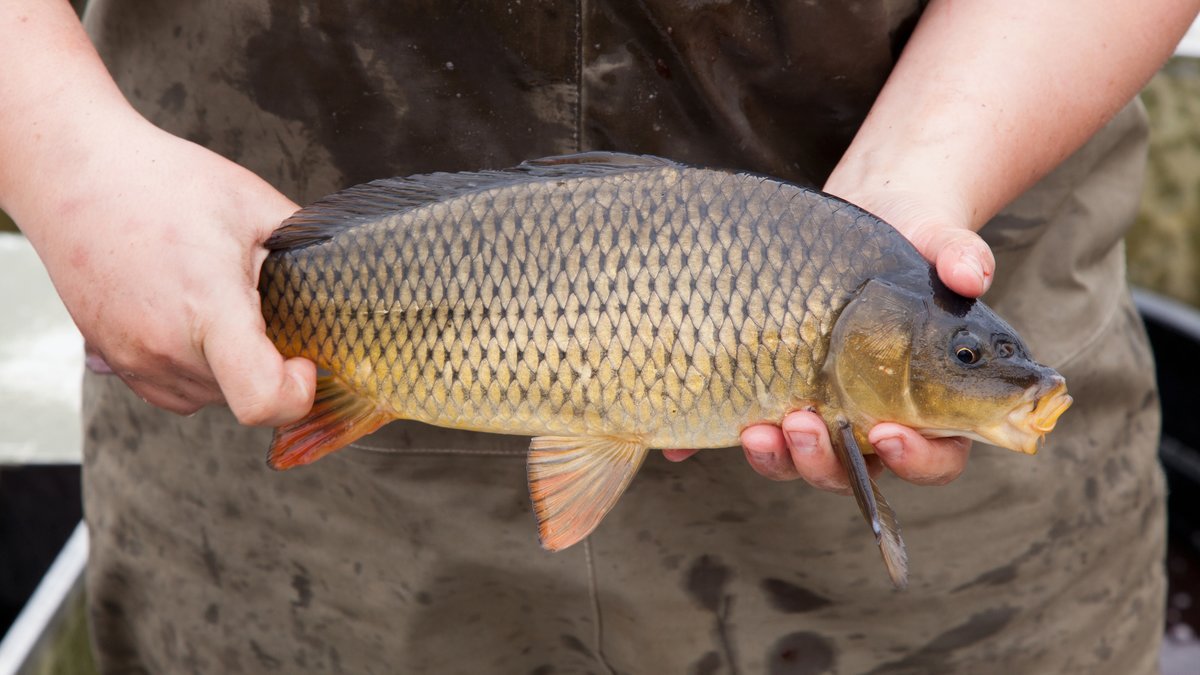
Common Carp: Introduced as a food source in the 1880s. They dominates the lake, disrupting the ecosystem and crowding out native species
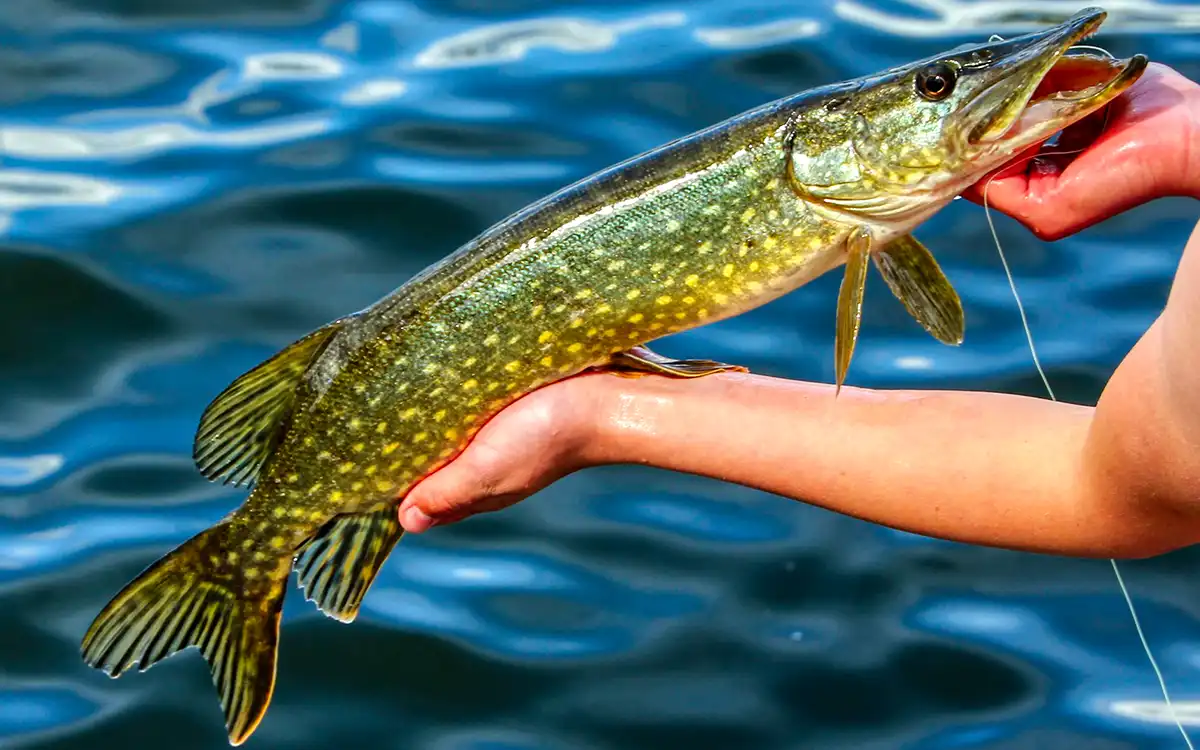
Northern Pike: threatens the delicate balance of Utah Lake’s ecosystem. Introduced illegal around 2010 , this voracious fish is known for its rapid reproduction and predatory nature.
Examples of Native Fauna:
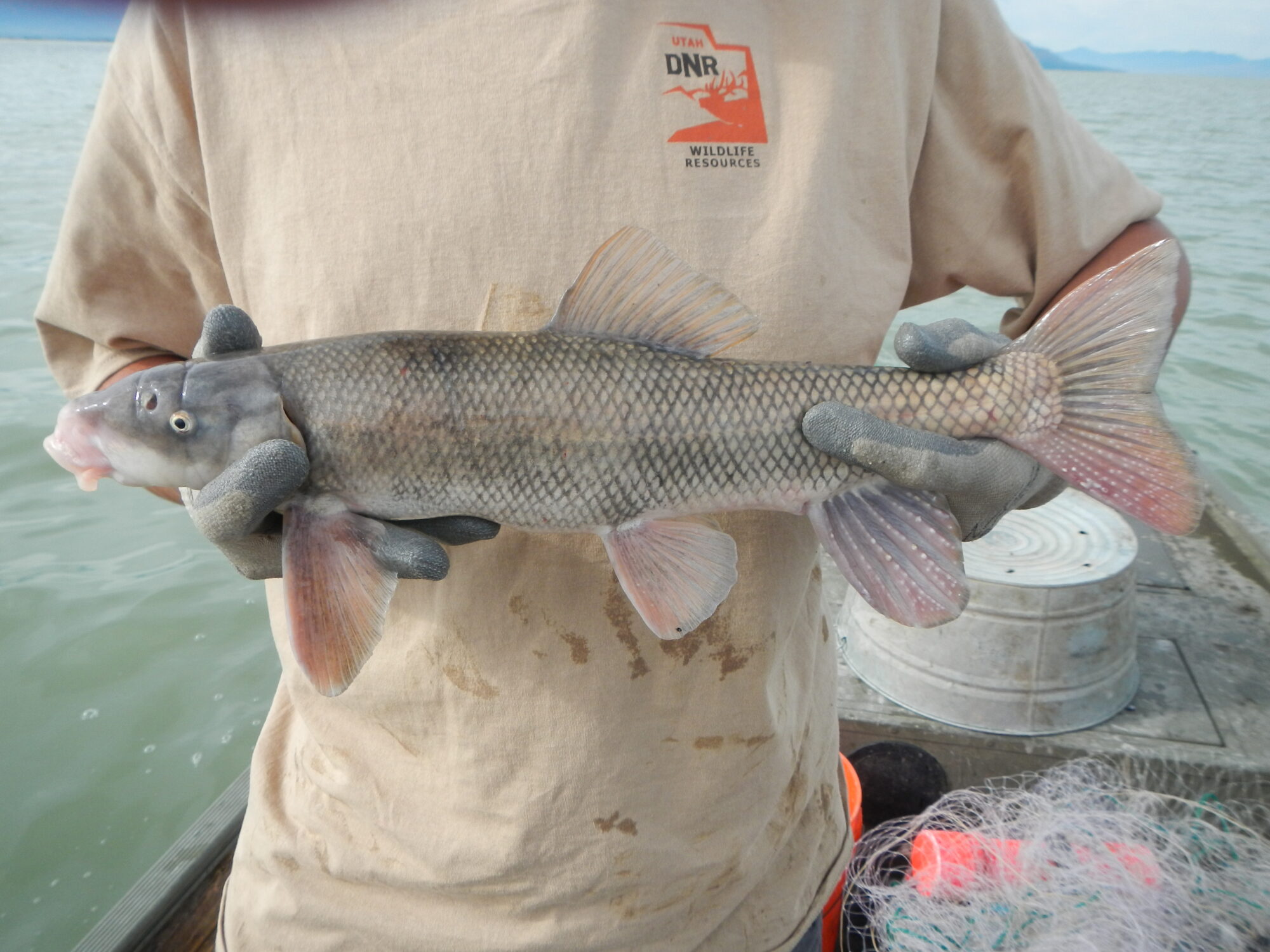
June Sucker: A native gem of Utah Lake. Once a plentiful food source for Ute tribes and early settlers, this unique fish now serves as an indicator of the lake’s health. Despite being threatened, it’s making a comeback thanks to conservation efforts.
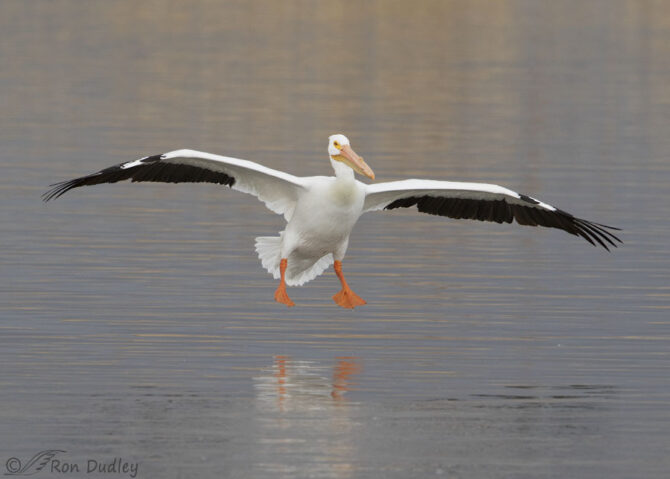
American White Pelicans: one of the world’s largest birds, these pelicans are a sight to behold as they skillfully fish in our waters. Their synchronized fishing and soaring flights remind us of nature’s harmony.
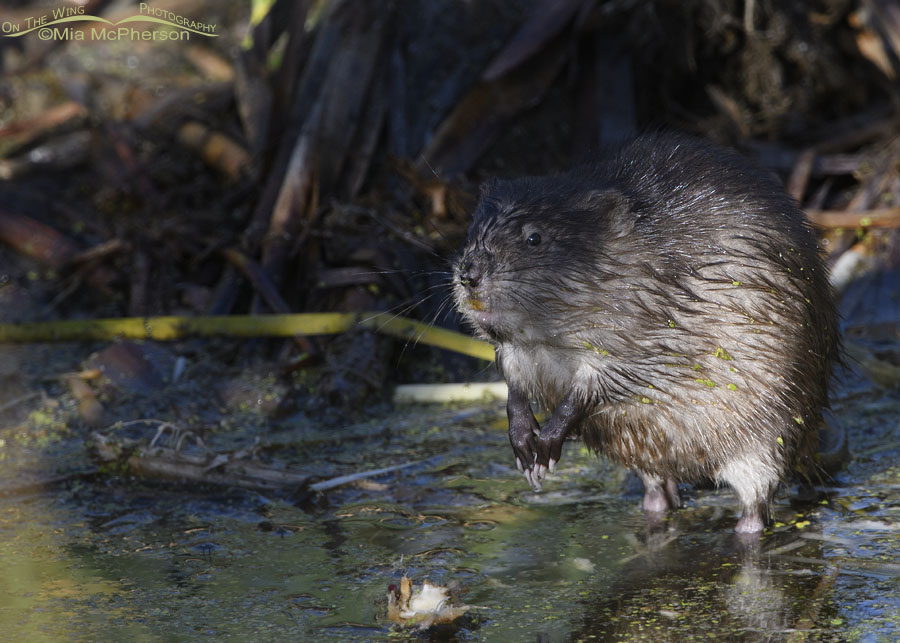
Muskrat: Often found in marshes, rivers, lakes, and ponds with slow-moving water, these industrious creatures play a significant role in shaping our aquatic landscapes.
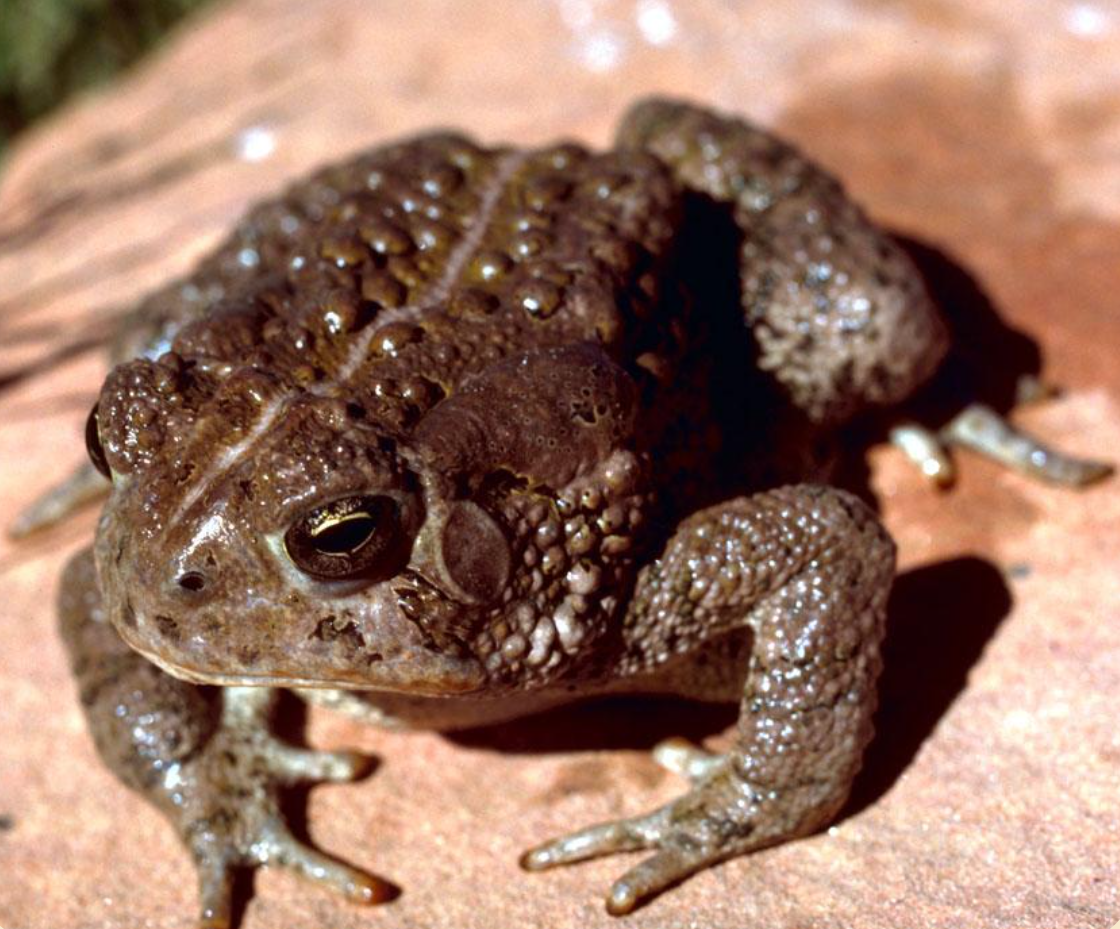
Woodhouse’ s Toad: Known for their round and stout shape, these toads are adaptable to many environments in Utah. They can inflate their bodies to appear larger, discharge a milky toxic secretion, or even urinate on a predator to defend themselves.
FLORA
Utah Lake is a vibrant ecosystem, home to a diverse array of flora, including a variety of plant communities. The flora ranges from native species, which are fundamental to the lake’s ecological balance, to non-native and invasive species, which can disrupt this balance. The intricate interplay between these native and invasive species plays a crucial role in shaping the health and future of Utah Lake. The conservation efforts at Utah Lake involve understanding and addressing the challenges posed by invasive species, while simultaneously protecting and promoting the native flora The richness and complexity of Utah Lake’s flora make it a fascinating subject for ecological study and conservation.
Examples of Invasive Flora:
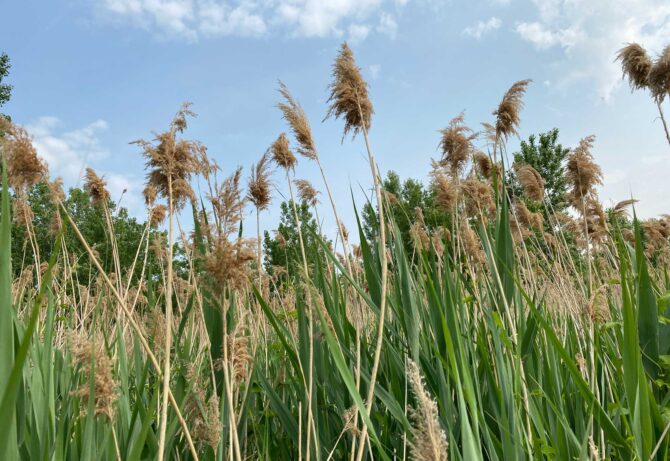
Phragmites: is highly invasive. Its rapid spread and towering 15ft stalks dominate the shoreline, outcompeting native species and altering the lake’s ecosystem. Despite its destructive nature, we have made huge progress in eliminating this plant so we can preserve the lake’s biodiversity.
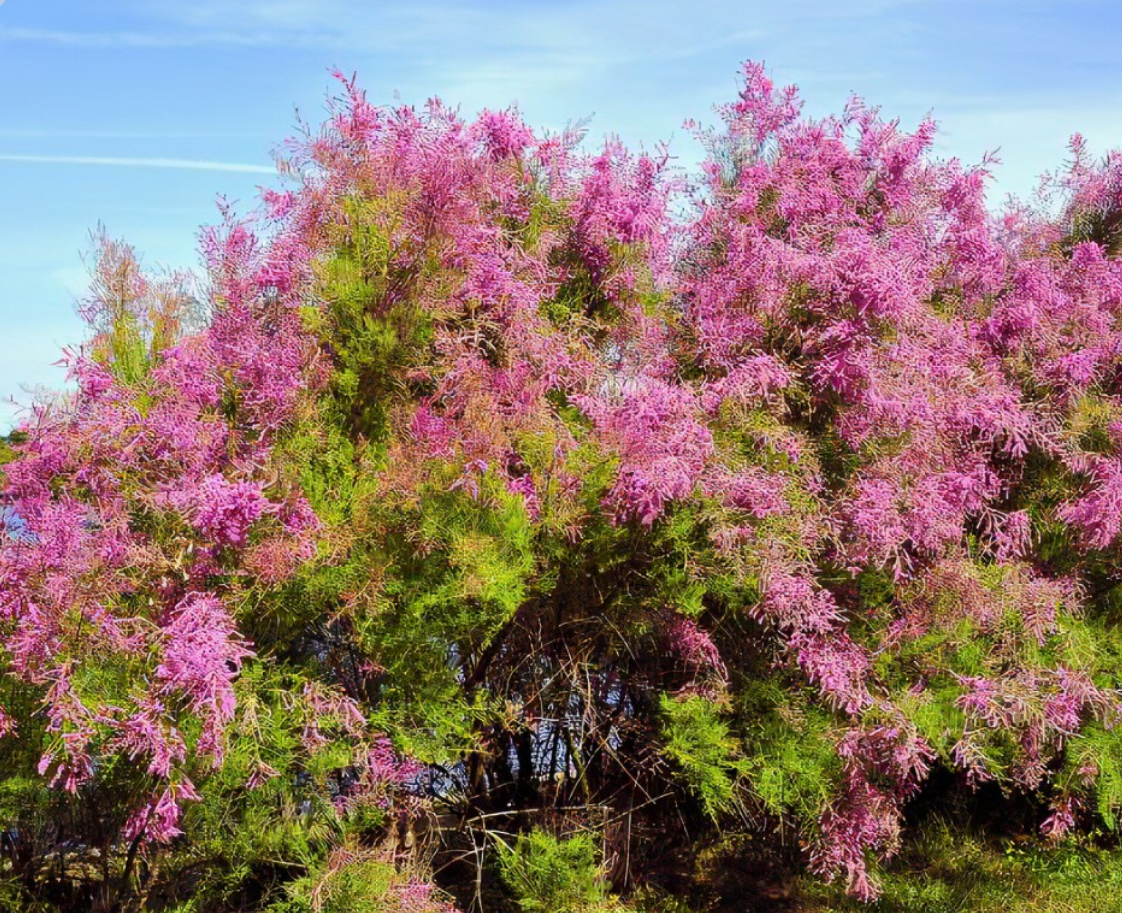
Tamarisk: Originating from Eurasia, these deciduous shrubs or small trees are an invasive species. Despite their beauty, with slender grey-green leaves and clusters of pink flowers, they pose a significant threat to the lake’s ecosystem by outcompeting native species.
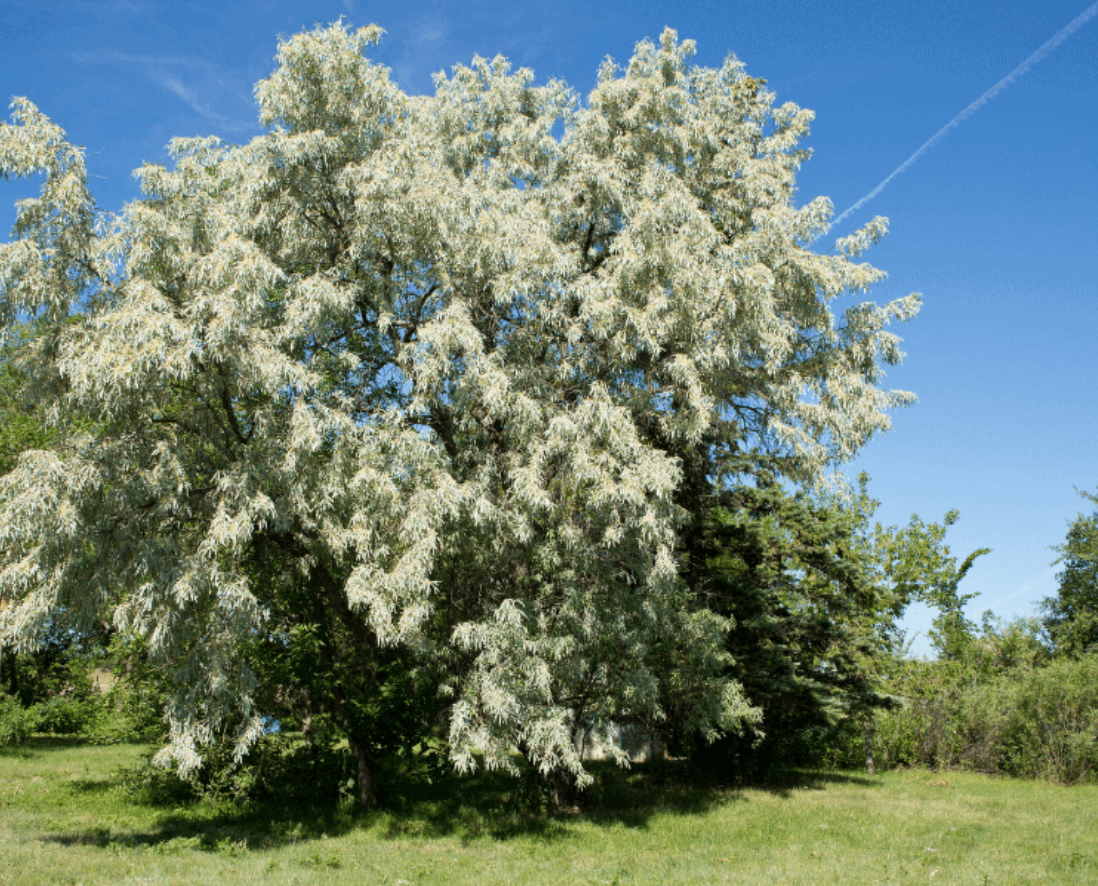
Russian Olive: This hardy tree with silvery-green leaves has become a significant concern due to its aggressive competition with native species.
Examples of Native Flora:
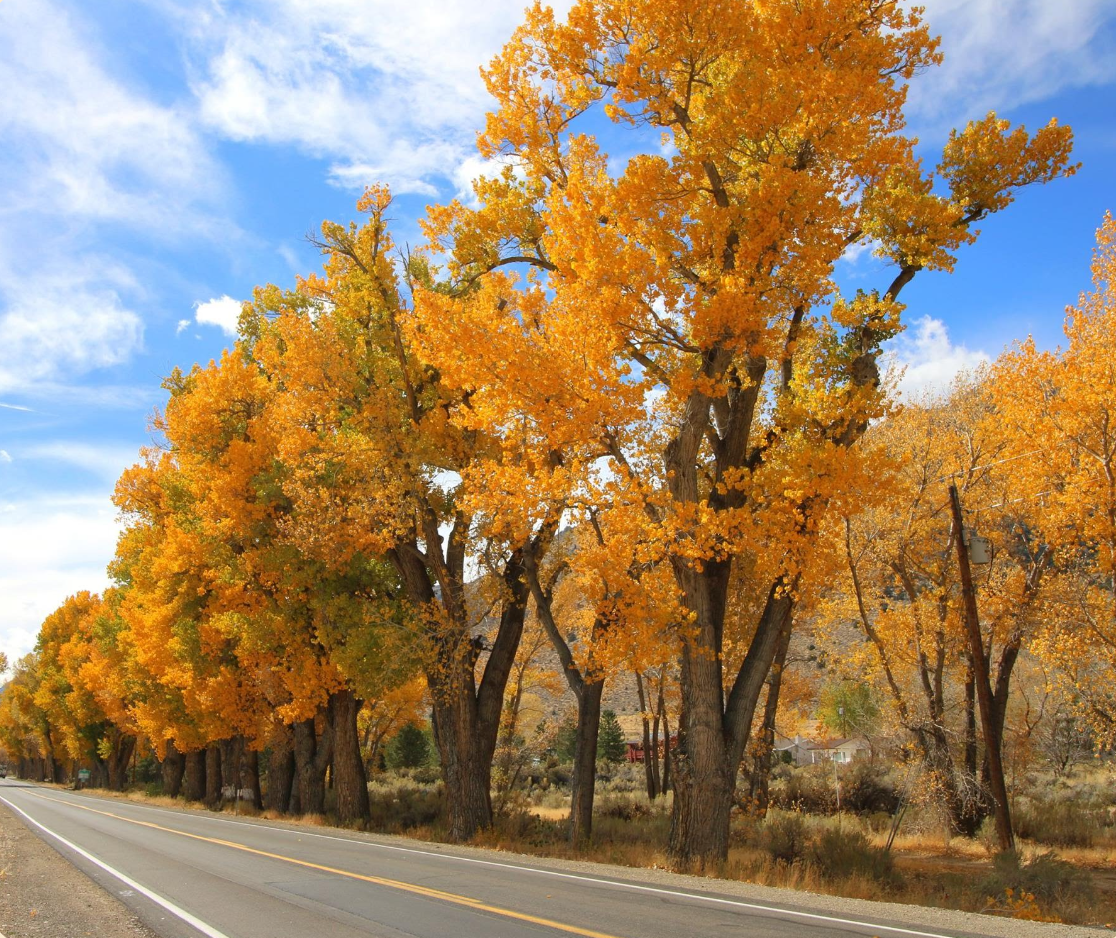
Fremont Cottonwood: They are Utah’s largest deciduous trees. They thrive along the lake’s moist low-elevation stream channels, providing shade and shelter for wildlife. In the fall, their leaves transform into a display of yellow and orange. In spring, they drop their cotton-like seeds, contributing to the lake’s unique landscape.
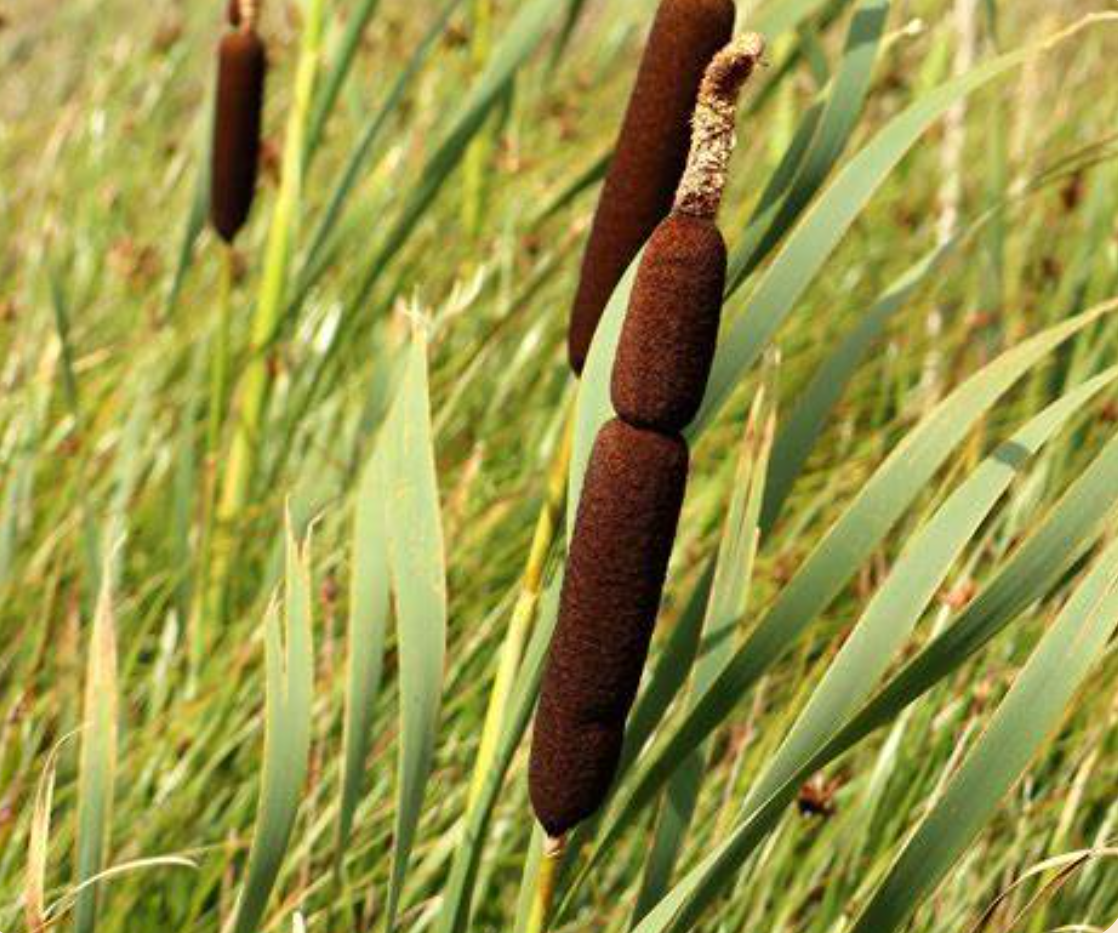
Cattail: These tall stiff plants play a crucial role in the lake’s ecosystem providing food and shelter. They thrive in the lake’s wetlands, and their extensive root system helps prevent soil erosion.
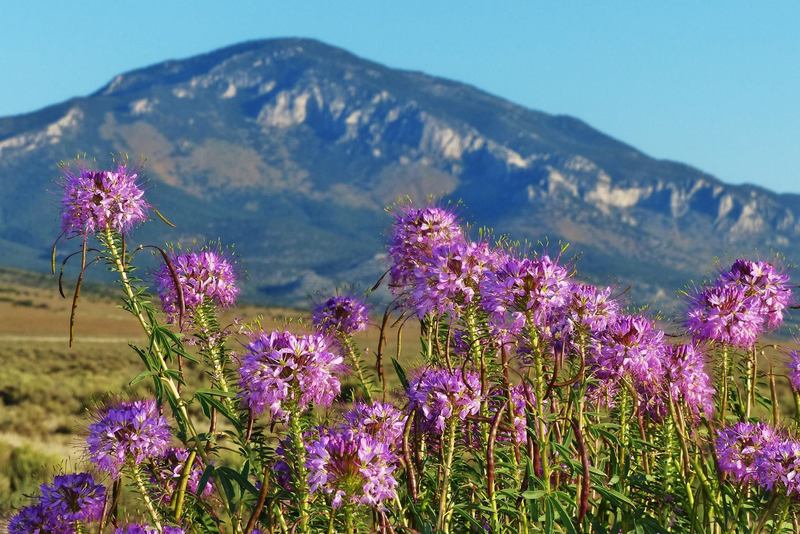
Rocky Mountain Bee Plant: a native flora at Utah Lake, this annual wildflower, with its bright pink to purplish flowers, is a beacon for pollinators. It has many uses, from medicinal to culinary, and was likely cultivated by Native Americans.
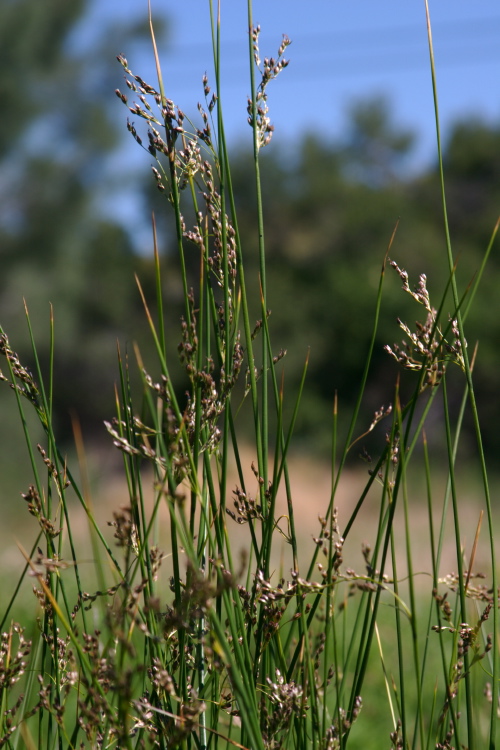
Artic Rush: It thrives in wet meadow and valley bottom sites. They are important for binding wetland soils and the stems can provide forage for livestock and native grazers. Despite its grass-like appearance, the flowers of Arctic Rush are more like those of lilies than their close relatives, the grasses.
WATER STORAGE and Quality
The level of Utah Lake is primarily affected by climate but is also affected by water use from the lake and its tributaries. Utah Lake drains 3,846 square miles of land, and the precipitation over this area varies from year to year. On average, about half the water that flows into the lake is lost to evaporation. In successive years of warm, dry conditions, the use and evaporation from the lake exceed the inflow to the lake, causing the lake level to go down.
The water that enters Utah Lake arrives from a variety of locations. Water comes from a variety of locations east of the lake, as far away as Trial Lake. For more information about how Central Utah Water Conservancy District helps manage the water in Utah Lake, check out their website or call 801-226-7100.
Snowpack produces the vast majority of all streamflow into Utah Lake, around 98% or more, with summertime precipitation producing the remainder of annual flow. Thus, above average mountain snowpack is the single most critical factor producing above average inflows to the lake.
– Julander and Clayton. Toward a greater understanding of Utah snowmelt hydrology, Proceedings of the Western Snow Conference, 2017.
Snow Water Equivalent (SWE) is the amount of water that would be released if the snowpack were instantly melted in place. SWE is important, as it is relational to the amount of water that will come down Utah’s rivers and streams as the snow melts.
Check out more details about snowpack at the KSL Snow Pack Levels.
The vast majority of Utah streamflow is snowmelt in origin. Areas of the watershed that hold the most snow and are close to a stream channel, such as north aspects higher than 8,000 feet, produce far more water than areas remote from stream channels or on southern aspects. Elevations below 7,500 feet produce little flow regardless of aspect. Aspens and meadows produce greater streamflow than coniferous forests.
Below is a list of the spots checked with snowpack in out watershed that are upstream form Utah Lake:
Trial Lake
Snowbird
Mill D North
Clear Creek
Brighton
Redden Mine Lwr
Beaver Divide
Lookout Peak
Timpanogos Divide
Payson R.S.
Daniels Strawberry
Cascade Mountain
Clear Creek
Parleys Summit
Hobble Creek Dry Fork
Louis Medow
All waters in the state are the property of the public, subject to the existing rights to the use thereof (Utah Code Sec. 73-1-1) https://le.utah.gov/xcode/Title73/Chapter1/73-1-S1.html?v=C73-1-S1_1800010118000101. There are several entities in Utah and Salt Lake counties that own water rights, or the right to use water in Utah Lake, including farmers, industrial users, and municipalities. These water users operate a dam and pumping station at the lake’s outlet to the Jordan River, allowing for regulation of outflow in accordance with demand from the lake.
The major source of the murkiness in Utah Lake has to do with the mountains that surround the lake, especially those on the east side. These mountains are made up of mostly limestone, which contains a lot of calcium carbonate, the same thing as chalk. When the water flows down over and through these mountains, it transports the calcium carbonate to Utah Lake where it concentrates to the point that the water looks a little “milky” or “murky.” The sediments resting on the lake bottom are then stirred up by wind-created waves and large bottom-feeding fish like carp. There are also other things in the water that add to the murkiness, like algae and tiny bits of plant matter that wash in, but mostly, the calcium carbonate gives the lake its special look.
There are many sources of nutrients, some natural (eroding of rocks, wildlife excrement) and some from humans (fertilizer, wastewater, livestock waste). The natural sources have been here since before humans began to settle the area and will continue as long as water continues to flow into the lake. These sources are generally small compared to the sources coming from humans who now live in the area. As the area continues to grow in population, more nutrients will be added to the lake, unless the wastewater, stormwater, and agricultural runoff is cleaned up more before it’s released back to the lake.
Before wastewater treatment plants were built during the mid-20th century, raw sewage was discharged into Utah Lake, but today all sewage is treated before being released back into the environment.
LAKE-RELATED POLICIES
Yes, you can! However there are certain rules for each marina and access points. Some of the main rules are: Pets must be on a leash at all times. You must pick up after your pets! Always check for Algae blooms
Yes, you can camp at Utah Lake. There are several areas around the lake where camping is available, including marinas and access points. Here are some areas:
Utah Lake State Park: This park offers a variety of recreational activities and facilities, including fishing access, swimming, boating, and paddleboarding. The RV campground consists of 31 sites, complete with water and power hookups. You can make camping reservations online. All campsites are available for reservations on a four-month rolling basis.
Lindon Marina: This marina offers a variety of services including boat launching, rental slips, picnic tables, and a convenience store. They also have an RV park with full hookups.
Lincoln Beach: Located at the south end of the lake, Lincoln Beach offers large pavilions, boat ramps, restrooms, covered picnic tables, camping, and an inland beach.
As for the fees, there is usually a fee associated with camping at these locations. For example, Utah Lake State Park charges a fee for camping. However, the fees can vary depending on the location and the amenities provided, so it’s always a good idea to check the specific rules and regulations of the area you plan to visit before your trip. Always remember to respect the rules and regulations of the area to ensure a smooth and enjoyable camping experience at Utah Lake.
At Utah Lake, fires are only permitted in designated fire rings. One location that you can start a fire is at Utah Lake State Park. The state park has established campfire facilities in their improved campgrounds and picnic areas. They also have RV campgrounds equipped with fire pits. Lindon Marina also has designated fire rings.
Please note that these locations have specific rules and restrictions regarding fires. It’s always a good idea to check the latest updates and rules before you plan your visit. Here are 3 things to remember when it comes to fires:
1
Always make sure your fire is completely out before walking away.
2
Never leave your fire unattended.
3
Always have water and an extinguisher nearby.
No, you are not allowed to bring fireworks to any of the marinas or access points around the lake. On all state and federal lands, including Utah Lake and privately owned unincorporated lands, fireworks are not allowed. The ban on fireworks is typically temporary, especially when there is a high risk of fire. Breaking any of the restrictions can lead to a class B misdemeanor offense and a substantial fine.
Visiting Utah Lake, one of the largest freshwater lakes in the Western United States, can be a delightful experience. However, it’s important to note that access to certain areas of the lake may require a fee. This is particularly true for boaters, as some marinas and access points may charge a fee for launching boats. For instance, Utah Lake State Park, Lindon Marina, and Saratoga Springs City Marina are some of the areas where there is an entrance fee for day use. These fees are typically used to maintain the facilities and ensure the safety and enjoyment of all visitors.
On the other hand, there are also some free areas around the lake where visitors can enjoy the beauty of Utah Lake. For instance, Lincoln Beach are public access points around the lake where visitors can launch their boats at no cost. While entrance is free at Lincoln Beach, there is a charge for overnight camping and pavilion rental.
Always remember to check the specific rules and regulations of the area you plan to visit before your trip to ensure a smooth and enjoyable experience at Utah Lake. Please note that these details can change, so it’s always a good idea to stay updated. Enjoy your visit to Utah Lake!
A park pass is a type of pass that allows you to access state parks, including Utah Lake State Park. You can purchase this pass online. Once you have this pass, you can enjoy access to Utah Lake State Park along with up to seven additional individuals In the same vehicle. However, it’s important to note that the pass does not cover camping access and camping discounts. So, if you’re planning to camp at Utah Lake State Park, which offers tent camping facilities, you would need to pay an additional fee. Always remember to check the specific rules and regulations of the area you plan to visit before your trip to ensure a smooth and enjoyable experience at Utah Lake.
Yes, you can bring motorized vehicles such as boats to Utah Lake. However, there are some rules and regulations you need to follow:
Registration and Insurance:
All motorized boats used in Utah waters must be registered and insured correctly.
Aquatic Invasive Species (AIS) Prevention:
All boats must complete a self-inspection prior to launching to prevent the spread of Aquatic Invasive Species and Mussels.
Boater Education:
All boaters must complete an annual mussel-aware boater education course prior to enrollment.
Safety Equipment:
Boats are required to carry the owner’s or operator’s liability insurance when operated on Utah waters. They should also have the necessary safety equipment on board.
Operation Rules:
There are specific rules regarding the operation of the water, including navigation lights and personal flotation devices (PFDs).
Alcohol Consumption:
Remember, don’t drink and boat. DUI laws apply in a vessel the same as in a vehicle.
Please note that it’s illegal to drive any vehicle that has a motor on an exposed lakebed or navigable river. Always remember to check the specific rules and regulations of the area you plan to visit before your trip to ensure a smooth and enjoyable experience at Utah Lake. For a complete list of Utah’s Boating Laws and Rules, you can visit the Utah Division of Outdoor Recreation’s website.
RECREATION
Utah Lake provides a wide range of recreational activities for everyone due to its diverse ecosystem. Boating, sailing, and paddle boating are available for boating enthusiasts, and there is a variety of fish species for anglers to catch, such as channel catfish, walleye, and white bass. With an average water temperature of 75 degrees, the lake is perfect for swimming. Nature lovers can indulge in bird watching, while adventure seekers can explore the numerous trails for hiking and biking. There are various campgrounds and RV sites situated around the lake, offering visitors the chance to spend the night. During the colder months, hunting, ice fishing, and ice skating are popular activities. Utah Lake’s natural beauty not only appeals to the eyes but also offers a wonderful opportunity for photography and enjoyable picnics in the great outdoors. Water enthusiasts can enjoy a variety of sports including jet skiing, kiteboarding, and water skiing. Before planning a visit, it’s important to check local regulations and Harmful Algal Blooms to ensure a safe and enjoyable experience.
Yes, you can rent equipment at Utah lake in these Areas:
TK Watersports: At Lindon Marina they offer a location-specific a one-stop shop for all your recreational needs at Utah Lake. They provide onsite boat rentals, jet ski rentals, water crafts, and other water sports equipment and water toys such as paddle boards, canoes, pedal boats, kayaks, small sailboats, wakeboards and water trampolines. They also offer VIP boat rental services or watersports charters.
Paddleboard rentals could be found at the On The Water Rentals
FISHING
Utah Lake is home to a diverse array of fish species. This includes the Largemouth Bass, one of the largest fish in the lake, and the White Bass, a popular species among anglers. The lake also hosts Black Bullhead Catfish and Channel Catfish, which are particularly active during the summer months. The Common Carp, a species that has adapted well to the lake’s conditions, can also be found in Utah Lake. Walleye, the most popular game fish in the lake, are prized for their firm, white flesh and hard-fighting nature. Other species include Bluegill, Northern Pike, known for its aggressive behavior and sharp teeth, Black Crappie, a popular game fish known for its delicious taste, and Yellow Perch, a species that prefers the cooler waters of the lake. These species contribute to the rich biodiversity of Utah Lake and offer a variety of opportunities for anglers.
Utah Lake is home to several fish species that are safe to eat. Panfish such as bluegill, perch, stream trout, and smelt are recommended as they feed on insects and other aquatic life and are less likely to contain high levels of harmful pollutants. Other fish in Utah Lake, including channel cats, have been tested and found to be safe, with some of the lowest mercury levels in the state. There is currently no advisory against consuming panfish, walleye, or white bass, which have all been tested and found safe to eat.
However, it’s important to note that some fish from specific areas in Utah may contain chemicals that could pose health risks. When contaminant levels are unsafe, Utah public health officials issue fish consumption advisories (https://deq.utah.gov/water-quality/utah-fish-advisories ) These advisories outline recommendations for limiting intake of specific fish at specific locations.
Based on various studies and advisories, it is recommended to limit or avoid consumption of certain fish species from Utah Lake due to their high levels of contaminants such as PCBs (polychlorinated biphenyls). These species include Black Bullhead, Channel Catfish, Common Carp, Walleye, and White Bass. The advisory recommends that consumption of carp and channel catfish be limited to one 4-ounce meal per month for adults, and that children, pregnant women, and women who can become pregnant avoid eating those fish from Utah Lake.
Please note that these advisories can change over time as new data becomes available, so it’s always a good idea to check the latest advisories before consuming fish from any body of water
Fishing at Utah Lake is governed by the Utah Division of Wildlife Resources (DWR), and they have established specific rules and regulations to ensure the sustainability of the lake’s fish populations. Here are some key points:
Licenses and Permits:
To fish in Utah Lake, you must have a valid fishing license. The type of license you need depends on factors such as your age and residency status.
Daily Limits:
The Utah Division of Wildlife Resources (DWR) sets specific daily limits for each species of fish in Utah Lake. These limits can change, so it’s important to check the latest guidebook before you go fishing. For example, the 2024 fishing guidebook states that the limit is 6 largemouth or smallmouth bass.
Specific Rules for Utah Lake:
Utah Lake has specific rules that differ from the general rules. These rules are listed in the “Rules for specific waters” section of the guidebook. For example, there’s no limit on northern pike, but all untagged northern pike must be immediately killed. All suckers must be immediately released.
Free Fishing Day:
Don’t miss out on Free Fishing Day, a perfect occasion to bond with a loved one while casting your lines into the water.
For a comprehensive understanding of the rules and regulations, you can refer to the latest Utah Fishing Guidebook provided by the Utah Division of Wildlife Resources. This guidebook is updated annually and contains detailed information about the laws, rules, and regulations that govern fishing in Utah.
Remember, these regulations are in place to protect and conserve fish populations, ensuring that future generations can also enjoy fishing at Utah Lake.
CARP
In the 1880s carp were introduced to Utah Lake to replace the dwindling number of native fish, including Bonneville cutthroat trout, and to provide locals with a hardy fish that was a popular food in other areas of the world. The carp had long-lasting, negative impacts on the lake and its native fish community because they destroyed cover that provided protection for small fish from their predators. The carp’s aggressive foraging habits eventually destroyed the pondweed on the surface and the plant life on the lake floor. This directly impacted the native fish population. Carp also reproduce and grow faster than June sucker. Because June sucker grow slower, they remain vulnerable to predators longer. In the early 2000’s, carp made up more than 90 percent of the biomass (weight) of fish in the lake. Since then, the June Sucker Program has removed over 35 million pounds of carp.
The removal project began in September of 2009 and has removed a cumulative amount of just over 35 million pounds of carp. Each year, the JSRIP had a goal of removing 3.5 million pounds of carp each year until 2018. Since then, due to a significant reduction in population, the target each year has been reduced to 1 million pounds.
Since the beginning, the project’s goal was to maintain intensive fishing for carp until 2018 and then reduce the fishing to a maintenance schedule. This maintenance schedule has been implemented and is significantly reduced from the intensive fishing and should keep the carp population levels low. Meanwhile, the June Sucker Program is working to restore vital habitat in the Provo River Delta Restoration Project that started construction in March 2020 and continues to work toward innovative solutions to restore the endangered June sucker.
Yes, you can eat the fish from Utah Lake. There are many species of fish you can catch, and many are described as tasty. There is a fish advisory for PCBs for the carp and catfish, recommending limiting consumption. More details here: DEQ Fish Advisories
JUNE SUCKER
The June sucker, named for its annual June spawning run, is endemic to Utah Lake. This means there are no other places in Utah or the world where June Sucker live naturally. The species was listed as endangered in 1986, and efforts are underway to recover the species. For more information about this fish and efforts to help it recover from its endangered status, visit the June Sucker Recovery Implementation Program’s website.
There were 13 native fish species that originally inhabited Utah Lake. Only the June sucker and the Utah sucker are still present. One species, the Utah Lake sculpin is considered extinct with the last specimen collected in 1928. The Bonneville cutthroat trout are primarily restricted to headwater streams. The least chub, native only to Utah and once abundant along the Wasatch Front, persists only in a small population in north Juab Valley and a few areas of the West Desert. The Bonneville redside shiner, mottled sculpin, leatherside chub, Utah chub, speckled dace, longnose dace, mountain whitefish, and mountain sucker are no longer in the lake but still exist in tributaries. All other species of fish present in Utah Lake were introduced intentionally as a food source or for recreational angling and compete with or prey upon the native fish.
